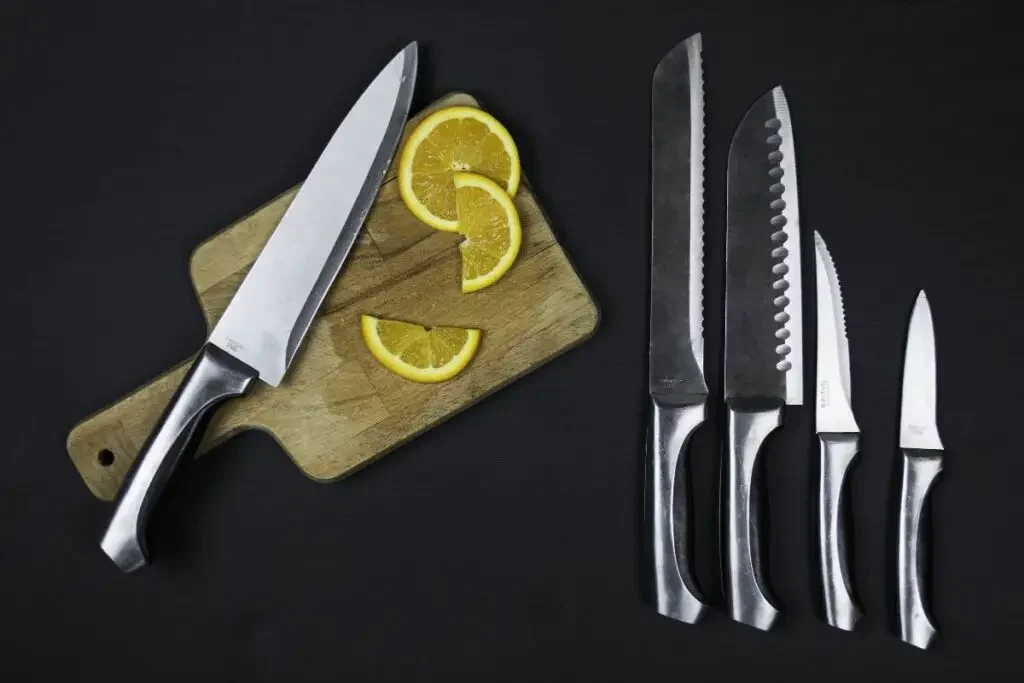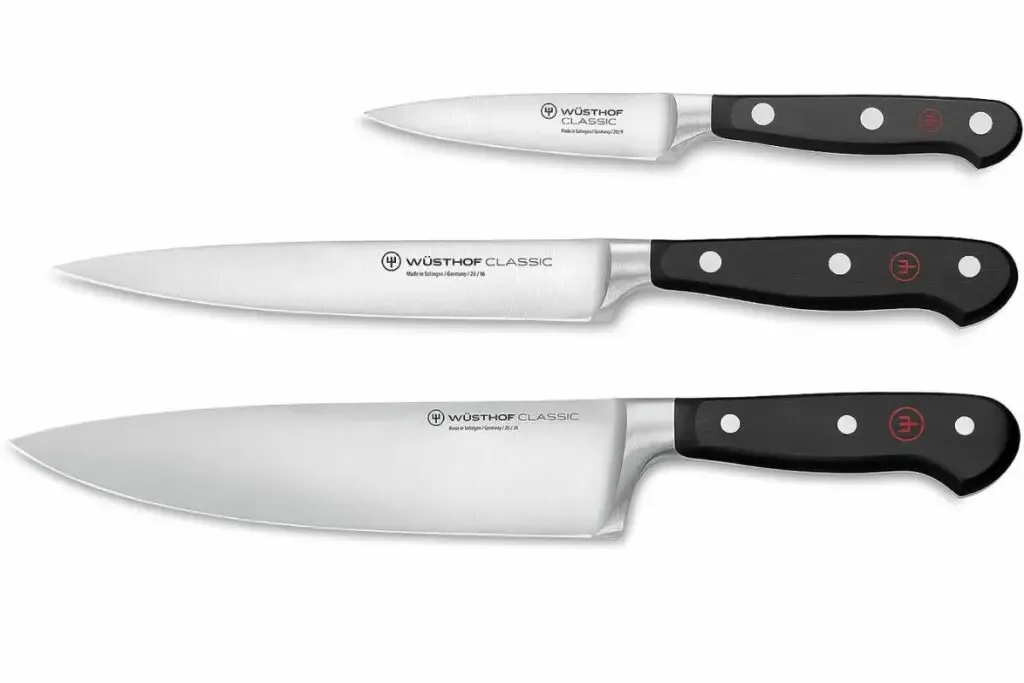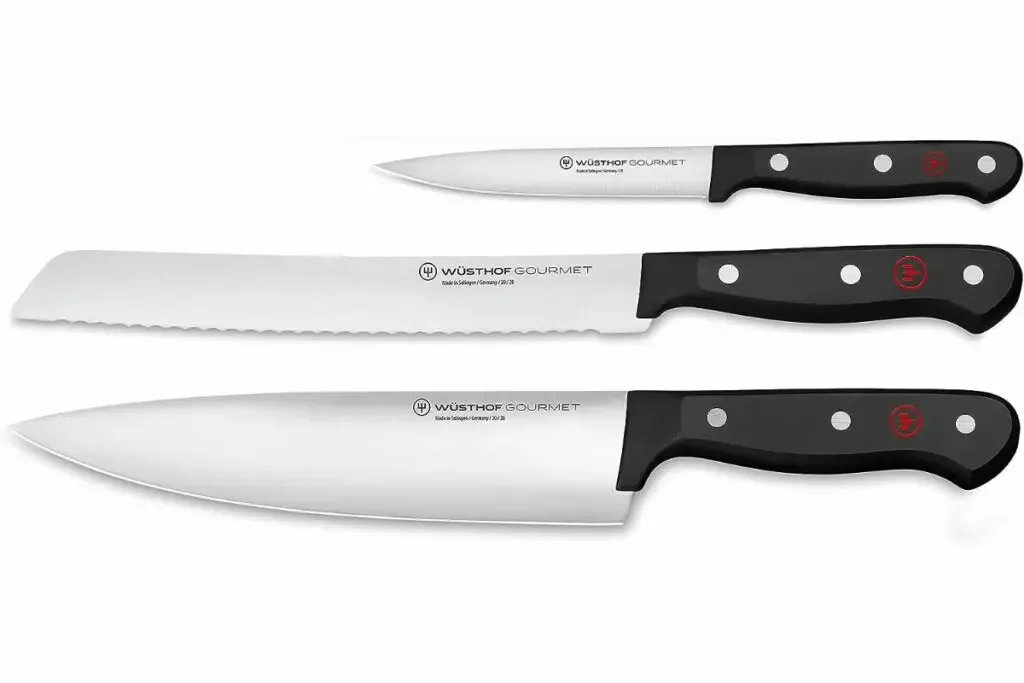As an Amazon Associate, we earn from qualifying purchases with no additional costs for you.
Many people swear by stainless steel knives, but are they the best option? Sheffield City, located in South Yorkshire in the UK, is renowned for the fine steel and particularly the stainless steel cutlery that they have been producing for over a century. Sheffield steel knives have always been known for their quality and longevity in service.
Way back in the 15th Century, Chaucer’s Canterbury Tales featured Sheffield as a producer of iron, the major component of steel. It is quite likely that the area was renowned for its metal craftsmanship centuries before that. It will come as no great surprise then to learn that stainless steel was perfected in Sheffield City itself.
It was Harry Brearley, a metallurgist, and inventor in Sheffield, who is credited with discovering “stainless steel” in 1913. At the time, he was researching how to make artillery gun barrels more resistant to corrosion and wear. A great deal of experimentation resulted in his adding 12.8 % chromium as the “stainless” component and 0.24 % carbon as the “hardness” component to a molten iron mix. Stainless steel was born.
The major advantage of stainless steel knives is their resistance to corrosion, dulling, and staining which makes them easy to clean with low maintenance even in adverse conditions. A disadvantage is that because stainless steel is a “softer” steel, the cutting edge will not be as long-lasting or rendered as sharp as that of the much harder carbon steel knife.
Let’s cut to the chase. The main purpose of having a knife is to cut stuff. Unless you are in the military of course, where stabbing someone with it might be important. With knife steel, like just about everything in life, there has to be a balance, a trade-off, a compromise.
Stainless steel knives are the first choice for many of us. Easily sharpened, hygienic, and relatively maintenance-free, they simplify our lives.
However, when it comes to sheer sharpness and cutting ability, the good old carbon steel knife is trumps. It holds its edge longer, can be sharpened to a very fine edge, and seems to slice forever.
When you are done, you had better clean it properly, dry it and lubricate it because rust will corrode that mighty edge in no time. Even looked after, a carbon steel knife ends up with a tarnished finish, not nearly as pretty as a highly polished spotless stainless blade.
If you are interested in checking out a range of stainless steel knives, you can find them by clicking here (Amazon link).
Is Stainless Steel Good For A Knife?

High carbon steel and stainless steel are both used to make survival knives, professional Chef’s knives, and even those employed by the home gourmet food artist.
Both types of knives have their pros and cons. Carbon steel requires a bit more care to keep from rusting, but it offers ease of sharpening. Stainless is hygienic, easy to clean, and, best of all, rust-resistant in adverse conditions.
The specialized stainless steel alloys used in knives these days are becoming better all the time as technology changes and improves. Sometimes not so well understood is the term “stainless.”
Stainless steel knives will rust, they are more stain-resistant or rust-resistant rather than rust-proof. The advantage is that they do not require the degree of cleaning and lubrication to prevent rust that a carbon steel blade (non-stainless) would require. Wash, wipe, dry, and put away generally does the job.
Higher chromium contents, with the addition of Molybdenum and Cobalt, improve the stainless capabilities, wear resistance, and sharp edge retention of the blade. The plus side is always its resistance to corrosion rendering it low maintenance.
This makes it ideal for professional chefs, the home cooker, and of course, the outdoorsman. The table below shows the major chemical compositions (by percentage) of three popular stainless steels used in knives. Of course, the major component is still Iron (Fe) at about 80 %.
It will be seen that all have a Chrome content of over 12 % and a Carbon content of over 4 %. The high Chrome content puts them into the stainless category, and the Carbon content improves hardness and, consequently, edge retention.
| N690 (German) | ATS34 (Japanese) | 154CM (USA) | |
|---|---|---|---|
| Carbon | 1.080% | 1.05% | 1.05% |
| Chromium | 17.30% | 14.0% | 14.0% |
| Manganese | 0.40% | 0.40% | 0.50% |
| Molybdenum | 1.1% | 4.0% | 4.0% |
| Silicon | 0.40% | 0.35% | 0.3% |
TIP: Choosing between stainless steel and carbon steel knives depends on your knife requirements and the knife’s purpose. Read our comprehensive article on the topic to help you decide!
Stainless Vs. Carbon Steel Knives: 12 Differences & Best One
Also present are small, almost negligible quantities, it would seem, of other elements such as Cobalt, Vanadium, Sulphur, and Phosphorus. These are vital, though, and are incorporated into the mix to enhance the characteristics being sort after in a particular knife steel.
The eternal search in specialized knife steels is to find the best balance between hardness, wear resistance, corrosion resistance, edge retention, ease of sharpening, and tensile strength.
Do Professional Chefs Use Stainless Steel Knives?

A professional chef earns his keep by producing quality foods in as short a time as possible. With this in mind, many will opt for the simply superior slicing ability of a super-sharp carbon steel blade.
Professional chefs may very well (but not always!) have a preference for the high-carbon steel knife. They appreciate that these can be honed to a ridiculously sharp edge, and the edge retention capability is certainly superior to that of the stainless steel blade. The less sharpening chefs have to do, the more productive they can be.
Both stainless steel blades and carbon steel blades are magnetic, so there is no conflict there. Both can be stored on a magnetic holder giving quick and easy access for a chef in a busy kitchen.
There is one stainless steel that will not stick to a magnet. The high zinc content of “Austenitic” stainless steels makes them non-magnetic. So along with Ceramic knives, plastic knives, and wooden knives, they would need to be stored in knife blocks around the kitchen.
TIP: Are you looking to buy a new whetstone? Check out our recommendations (we personally use the first three ones):
Our PRO choice whetstones combo (Amazon links):
- Fixing stone: Whetstone SHAPTON Ceramic KUROMAKU #320
- Sharpening stone: Suehiro CERAX soaking whetstone: Medium #1000
- Finishing stone: Whetstone SHAPTON Ceramic KUROMAKU #5000
Our budget choice (Amazon link): Sharp Pebble Extra Large Sharpening Stone Set
Pros Of Stainless Steel Knives
The super sharp, durable edge of a carbon steel blade has one big downside, rust. Leave that knife a day or two in a damp condition, and then the iron bugs will be into that knife in a flash. Apart from ruining the sharp cutting edge, rust eats away at the surface, pitting the metal.
You can remove the rust, but that rusting leaves pit marks on the surface which make nice bug traps and are impossible to eliminate without refinishing (regrinding) the surface.
Along comes our modern stainless knife steel, and the rust problem largely goes away. That high chromium content makes it an all-weather tool, easy to clean, and low maintenance.
Modern chrome steels allow a pretty good edge with an acceptable level of edge retention. Its resistance to corrosion from water and humidity makes it the sensible choice for any task in any climate or environment.
Of course, the stainless steel option is good news for the fisherman, camper, or hunter. Low maintenance, low rust, and a perfectly acceptable edge when sharpened.
Just as an aside, if you have a rust issue, one delicate and extremely effective way of removing the rust is to crumple up a piece of aluminum foil and rub the rust away. The foil does not damage the surface and removes no metal, but it sure moves that rust off.
This is a pretty good tip to keep in mind. It works perfectly on tools, pocket knives, and even the blued parts of a firearm. It wipes away the rust, nothing else. This little gem just may help you a little to keep your everyday carry knife (EDC) in top condition, as well as those kitchen knives.
Cons Of Stainless Steel Knives
There is room for debate as to which is easier to resharpen, a carbon steel blade or a stainless steel blade. My experience is that the stainless knives I am used to are of a softer material than carbon steel. The stainless steel metal edge is re-cut way easier on a whetstone during sharpening.
The argument against this is sound as well. The more modern stainless steel alloys used in knives generally have a higher carbide content than before.
Adding Vanadium to the alloy is known to increase the presence of carbides, thereby making it more difficult to cut away an edge and re-sharpen the blade, but it adds to the edge retention capability. Always seeking that balance!
Notwithstanding that, the edge of a carbon steel knife will outlast that of a stainless steel knife. And when you are in an industry that requires time, such as cheffing, sharpening is downtime. Downtime is unproductive time, which is an expensive time.
The disadvantage of stainless steel knives is that they cannot be sharpened to the high degree that a carbon blade can. The cutting edge is not as durable either, which is a real downside for someone using the blade every day all day. It means more frequent sharpening episodes.
TIP: Did you know that the steel your knife is made from affects how easy or difficult it is to sharpen? Explore this topic with our in-depth article on the subject!
List of The Easiest Knife Steels To Sharpen (With Examples)
Best Stainless Kitchen Knives Set
Located in a picturesque setting near the Wupper River is the West German city of Solingen. Also known as “The City of Blades,” Solingen has been known to be the center of master craft blade smiths making superb knives for centuries.
Here you will find the home of Wusthof, one of the premier manufacturers of fine cutlery in Germany for over seven generations. With five-star ratings in nearly every category, these fine stainless steel knives have a place in your kitchen.
Wüsthof’s Three-piece Paring Utility Knife Set

The Wüsthof Classic Series of knives is a set of professional-grade stainless steel knives (Amazon link) made with full tang triple riveted hi-impact synthetic handles. The polypropylene handle slabs ensure high impact resistance, and the full tang just adds to the overall strength of the knife.
Each blade, carefully made to the exacting standards you would expect from a traditional German manufacturer, proudly displays the “Solingen” brand name.
Classic Series Knives are made from a single uniform block of High Carbon Stainless Steel, laser cut with precision and hardened and tempered to 58 degrees HRC.
The Rockwell C scale is a universal method of measuring the hardness of steel, in this case, knife steels. A particularly hard but brittle knife steel would run out at 60 to 62 Rockwell C. At 58 Rockwell, Wüsthof is hitting the optimum sweet point for hardness for stainless blades. Hard enough for a good edge, soft enough to sharpen easily.
This three-piece knife set consists of a 3 1/2″ Paring Knife, a 6″ Utility Knife, and an 8″ Cook’s Knife.
Their precision edge technology produces an edge as fine and as sharp as can possibly be. Crafted to perfection, resistant to dulling, corrosion, and staining, WÜSTHOF carries the family limited lifetime guarantee. That is a good reflection of the faith they have in the design, materials, and workmanship.
Wusthof Gourmet Three Piece Cooks Set

The WÜSTHOF GOURMET SERIES consists of a – 3 Piece Cook’s Knife Set (Amazon link) that Includes a 4.5″ utility knife, an 8″ bread knife, and an 8″ chef’s knife.
Again, they have the trademark hi-impact synthetic handle riveted on in three places, along with the strength-enhancing full tang concept. Precisely cut with the latest laser and an edge honed second to none, these are professional knives made to work.
Wusthof recommends hand washing only as dishwashers do tend to have an abrasive in their washing powders which will ultimately dull the fine finish on the blade. Only knives of this quality carry the legendary “Solingen: name.
Conclusion
There are no knife steels that score 10 out of 10 points for toughness, corrosion resistance, and edge retention, all at the same time.
Toughness is the measure of how resistant the steel is to breaking and or succumbing to chips on the edge. Edge retention is the knife blade’s ability to stay sharp and maintain an effective cutting capacity. These two desirable features are unavoidably horizontally opposing properties. You improve on one at the expense of the other.
Similarly, with the hardness and corrosion factor. So, the reality is that there are compromises to be made to find the middle ground.
All knives, stainless steel, carbon steel, ceramic, or otherwise, will need to be resharpened with a frequency directly proportional to the amount and type of use they are put to. All knives will also need a bit of TLC, so it’s up to you to choose the best balance that suits your circumstances.
The stories of someone who has a knife that chopped a tree in half, split a bundle of firewood, skinned a buffalo covered in mud, prepared a meal for fifty, and still held an edge good enough to shave with is just that, a story, more than likely moon shine inspired.
TIP: Japanese knives are made from a variety of steel types, each with its own benefits and characteristics. Find out all about the steel used in Japanese knives in our article on the topic!
Japanese Knives Steel Types (Complete List with Explanation)
